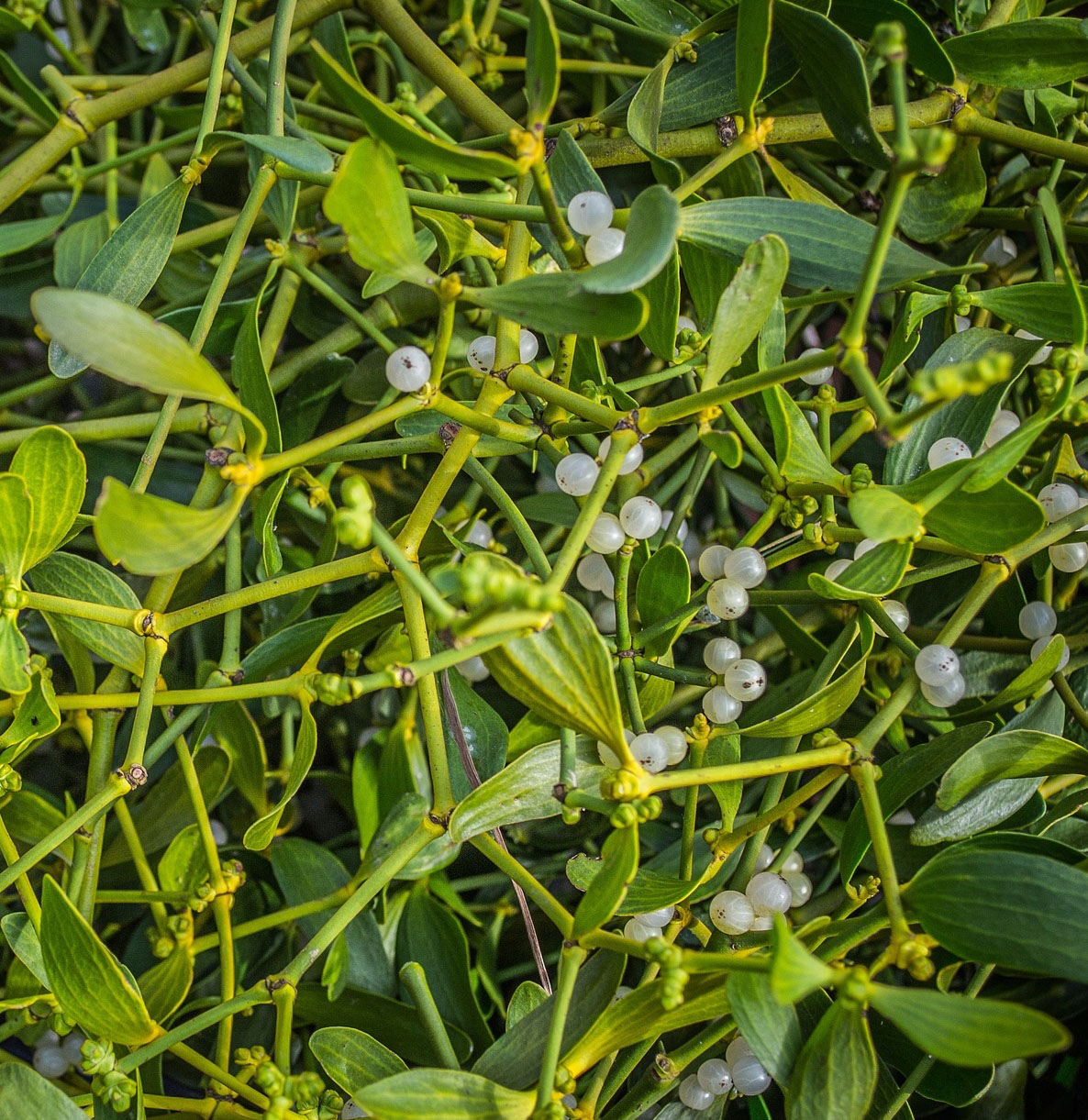By Terry W. Johnson
Mistletoe is indeed a curious plant. We all recognize it as one of the handful of plants we associate with Christmas. At the same time, mistletoe is also a valuable wildlife food plant. This begs the question, how can a parasitic plant that grows in the tops of hardwood trees be either?
Believe it or not, the practice of adorning our homes with sprigs of mistletoe stems from ceremonies practiced by the Druids. These leaders in ancient Celtic culture would hang mistletoe in their homes during the winter. By so doing, they were convinced they were providing warm sanctuaries for woodland spirits that hid in mistletoe during harsh weather.
For this reason alone, it is not surprising that for centuries the plant was banned from Christian churches.
The custom of kissing beneath a frond of mistletoe probably evolved from Norse mythology. One of those myths tells us that since mistletoe was dedicated to the goddess of love, if a couple embraces beneath a tree hosting a mistletoe plant, they will enjoy good health and experience good luck.
Washington Irving, author of “The Legend of Sleepy Hollow,” advised good manners dictate kissing is allowed beneath a branch of mistletoe only while berries are still on the plant. Each time someone steals a kiss they are supposed to remove a berry. Should anyone be so rash as to attempt to kiss beneath a berryless frond of mistletoe, they were considered out of line.
Centuries after mistletoe joined the poinsettia, holly and evergreen trees as plants Americans consider Christmas plants, wildlife food habits studies revealed that this odd plant is also valuable for wildlife.
Dense masses of mistletoe are sometimes referred to as witches’ brooms. When mature, mistletoe plants form large tangles of branches that birds sometimes use as nesting sites. A few of the birds known to nest in them are the mourning dove, chipping sparrow, house wren and Cooper’s hawk.
The list of animals that eat mistletoe in Georgia is impressive. Topping the list of are insects. The best known and most beautiful of these is the great purple hairstreak. It is the largest hairstreak found in the state. This stunning butterfly has an orange abdomen and wings that are metallic blue and green highlighted with white, red and blue patches. The great purple hairstreak nectars on the mistletoe's tiny blossoms and uses the plant as its host plant.
Mistletoe blooms are also visited by literally hundreds of insects including the likes of honeybees, native bees, flies, ants and others in search of both pollen and nectar.
Although it is not commonly known that mistletoe provides food for pollinators, the plant is recognized as a source of both forage and berries for other wildlife. From late fall into winter, balls of mistletoe plants are adorned with white berries. The berries, which are actually fruits, are an excellent source of amino acids and carbohydrates.
Among mammals, squirrels and eastern chipmunks eat the fruits. Birds are also especially fond. The list of species that dine on the berries includes the American goldfinch, cedar waxwing, mourning dove, eastern towhee, blue jay, American robin, evening grosbeak, northern flicker, eastern bluebird, dark-eyed junco, eastern meadowlark, purple finch, Carolina chickadee and white-breasted nuthatch.
An interesting relationship exists between mistletoe berries and birds. In exchange for providing them with food, birds then spread the mistletoe's seeds far and wide.
It seems that each berry contains two to three seeds, which are encased in a sticky pulp. Some of the seeds are dispersed through bird droppings, but others by bill wiping. When a bird that has eaten mistletoe wipes its bill on a branch, there is a good chance the sticky pulp and seeds are both spread on the branch.
Some researchers go so far as to suggest the berries contain a substance that encourages birds to wipe their bill soon after they have fed on the berries. Since mistletoe seeds often only grow on the same species of tree on which they were produced, the sooner the bird wipes its bill, the better the chances it will deposit mistletoe seeds on a tree of the same species.
While I must admit I know little about the food habits of Santa's reindeer, I do know white-tailed deer are very fond of the mistletoe’s foliage. Since most of the plants grow well above the reach of whitetails, these large ungulates often have to depend on strong winds blowing down tree limbs with mistletoe plants attached to avail themselves of this high-protein forage.
One of the biologists who played a key role in the reintroduction of white-tailed deer to all parts of the Peach State told me that mistletoe was often used when they were trapping deer. Apparently, many of the deer stocked across the state were lured into large box traps baited with mistletoe.
Having heard about both perspectives on mistletoe, what do you think? Is it a cherished Christmas plant or a wildlife plant?
In my mind, it is indeed both.
Terry W. Johnson is a retired Nongame program manager with the Wildlife Resources Division and executive director of The Environmental Resources Network, or TERN, friends group of the division’s Nongame Conservation Section. (Permission is required to reprint this column.) Learn more about TERN, see previous “Out My Backdoor” columns, read Terry’s Backyard Wildlife Connection blog and check out his latest book, “A Journey of Discovery: Monroe County Outdoors.”





















